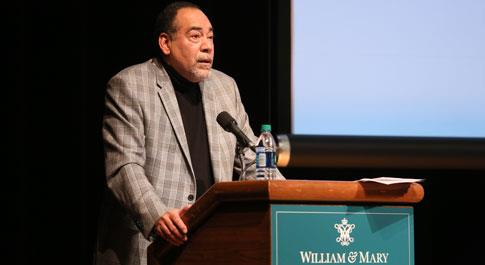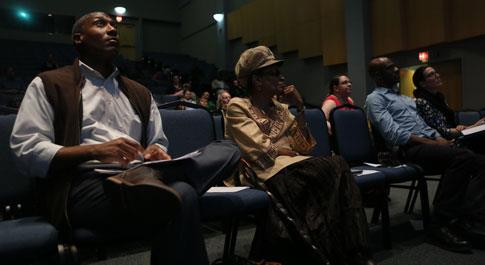Institute for Historical Biology symposium explores slavery and memory
Michael Blakey looked out over the audience in Commonwealth Auditorium and talked about the importance of asking permission.
“Asking permission remains a central part of the practice of archaeology,” he said. “It’s the central difference between collaboration and exploitation, democracy and slavery, love and rape.”
Blakey was the leadoff speaker at a half-day symposium, titled Archaeology of Slavery & Memory in the Diaspora. The Nov. 29 event was sponsored by William & Mary’s Institute for Historical Biology, the Africana Studies Program and the university’s Department of Anthropology. Blakey is the director of the Institute for Historical Biology as well as NEH Professor in William & Mary’s Department of Anthropology.
He discussed his own work as director of the New York African Burial Ground, which began when he was on the faculty of Howard University. He then introduced a number of symposium participants, individuals, he said, who have “looked at the remnants of slavery from Richmond to Rio, from New York to Dakar, from Charles City County to Washington, D.C.”
The featured guest speaker was Tania Andrade Lima of the Museu Nacional/Universidade Federal do Rio de Janeiro in Brazil. She was the chief archaeologist on the discovery of the Valongo Wharf. Now a candidate for a UNESCO site, the wharf was unearthed during preparations for the Olympic Games. The Valongo Wharf was the site of the unloading of an estimated half-million enslaved Africans into Brazil.
The symposium included work by two other William & Mary archaeologists. Joseph L. Jones, assistant professor of anthropology, discussed his work at the East Marshall St. Well Project in Richmond. Blakey presented the work of Autumn R. Barrett, co-director of the Remembering Slavery, Resistance and Freedom Project and senior research associate at the Institute for Historical Biology. Barrett was unable to attend the symposium.
Blakey discussed the formation of an archaeological paradigm based on public engagement. He said the concepts undergirding the collaborative clientage model came out of the New York African Burial Ground project, which began in 1991.
Blakey was director of the African Burial Ground project, which saw the extraction of 419 sets of skeletal human remains from a 5.5 acre site in lower Manhattan that had been earmarked for a U.S. government building.
The proposed federal building would sit atop a portion of a 17th- and 18th- century graveyard: “It originally contained an estimated 15,000 burials of the enslaved Africans who built the city and the economy of New York,” Blakey said.
The construction was halted by what Blakey called “enormous and extended protest over the burial ground’s desecration by the U.S. government and its archaeologists.” The protest, largely by members of the African American community, resulted in a smaller government building being built— and a national monument within the U.S. National Park service and visitor center commemorating the site.
The protest also brought in a new set of archaeologists, led by Blakey, a group that developed what he termed “publically engaged archaeology” at the African Burial Ground project.
He explained that the publically engaged archaeology concept is based on the assumption that living members of descendant communities have the right to honor and to memorialize their dead.
“Consistent with the simultaneous demands of indigenous peoples worldwide, we instituted a program of research on this basis, requiring scholars to ask permission of the descendants to help tell a story of themselves in which they were interested,” Blakey said.
He told the symposium audience that the clientage model forged at the New York African Burial Ground has been widely adopted, as has a number of related terms and concepts. One central idea, Blakey said, is the identification of a project’s “ethical client,” representatives of a descendant community (or their surrogates). He noted that the term “descendant community” has entered the working lexicon of archaeologists worldwide, as have other concepts.
“Even the now-conventional term ‘enslaved African,’ as a replacement for the term ‘slave,’ came through the project from the African American community with which we were engaged,” he said.
And Blakey stressed that the science didn’t suffer for the sake of community collaboration. He said his group produced a 2,500-page report published in 2009 that “included the most sophisticated bioarcheological analysis yet conducted anywhere.
“As director, I know I strain humility with that comment. But we all met on the project here in May, all the researchers from 25 years before, and we couldn’t find anything that was more sophisticated than what we produced,” he said. “It would be unfair to them and to all those who circled around us to make it possible to say anything else.”
Joseph Jones was one of the researchers involved in the African Burial Ground project, starting as an osteological technician when he was an undergraduate at Howard University. Jones examines the teeth recovered from skeletal remains to try to trace the geographic origin of the individuals through trace elements and stabile isotopes. The presence of lead, he said, is especially helpful in determining geographic origin, as exposure to lead was much more common in colonial America than in west Africa.
As a member of the Institute for Historical Biology, Jones took the concepts of the African Burial Ground clientage model to Richmond when he became involved in the East Marshall St. Well Project.
Jones gave an overview of the project at the symposium. The well was discovered in 1994 during construction for a building on the campus of Virginia Commonwealth University. Jones played a video documentary by VCU scholar Shawn Utsey telling the story of the well, which was found to contain the remains of more than 50 individuals — all African in origin.
The well was found to be the interment site of cadavers used by anatomists at the old Medical College of Virginia. The video narration included a description of how a MCV employee named Chris Baker acted as “resurrection man,” robbing graves to supply material for dissections in the late 19th and early 20th centuries.
Jones said the African Burial Ground and the East Marshall St. Well projects are examples of a new kind of anthropology whose practitioners identify themselves as members of the “decolonizing generation,” whose aim is “to rescue anthropology from its colonial moorings.”
He explained that both the New York burial ground and the well project in Richmond also incorporated the concept of “surrogate ancestry” — a group of people who can be entrusted “to speak for those who can’t speak for himself.” In that spirit, he said the Well Project brought together five community consultation sessions to discuss the work.
“What’s important is that the goal of the consultations was not simply to inform — that was one goal, to inform people about the well so they knew as much as possible,” Jones said. “Secondarily, it was to solicit input as to what should be the disposition of these remains.”
The community consultation sessions generated formation of the 10-person Well Planning Committee, a group Jones said served as surrogate descendants of the people in the well to help guide the study while maintaining the dignity of the subjects. He told the symposium that a draft set of recommendations for the study is being finalized.
Jones said the Well Planning Committee discussed at length the matter of the final disposition of the remains taken from the well.
“We talked about Evergreen Cemetery in Richmond, where many prominent African Americans are buried, and we discussed some other sites,” he said. “But we started, and came back to, the African Burial Ground as the final resting ground for these remains.”
As Autumn Barrett was unable to attend the symposium, Blakey gave her presentation, which Barrett had given in August at the World Archaeological Congress in Kyoto, Japan. It centered around her work as co-director of the Remembering Slavery, Resistance, and Freedom Project.
“The project went around the state, asking African Americans and Euro Americans how they felt about slavery and its interpretation,” Blakey explained, noting that the Remembering Project, as it became know, followed the New York African Burial Ground’s community engagement model.
The Remembering Project was formed in 2010, as a response to the Virginia General Assembly’s Martin Luther King Commission’s charge to create a database of Virginia burial grounds that held the remains of enslaved people.
“The Commission intended to use this database to celebrate the sesquicentennial of the Emancipation Proclamation in 2013, by placing American flags on the marked and unmarked graves of men, women and children who died enslaved,” Blakey said.
The Remembering Project conducted a set of discussions with members of Virginia communities in 2011 and 2012, sessions that produced a number of revelations.
“We learned that the process of engagement and the dialogues that emerged were considered by participants as meaningful commemorations in themselves,” Barrett’s presentation read. “We did not expect this.”
Barrett’s presentation continued that proposals for exhibits and lectures were well received by discussion participants. “The idea of placing flags on the graves of enslaved people who were not offered citizenship, however, was not,” Blakey read.
The symposium concluded with a panel discussion and audience Q & A. Panelists included Paul Gardulla, curator, Smithsonian National Museum of African American History; Ibrahima Thiaw, Université Cheikh Anta Diop of Dakar, Senegal; Stephen Lubkemann, George Washington University, all of whom are participants in the Slave Wrecks Project. Other panelists were Ana Edwards of the Sacred Ground Reclamation Project; Janet “Queen Nzinga” Taylor, East Marshall St. Well Project; Brian Palmer and Erin Holloway, Make the Ground Talk documentary.















